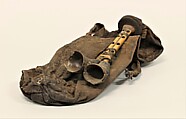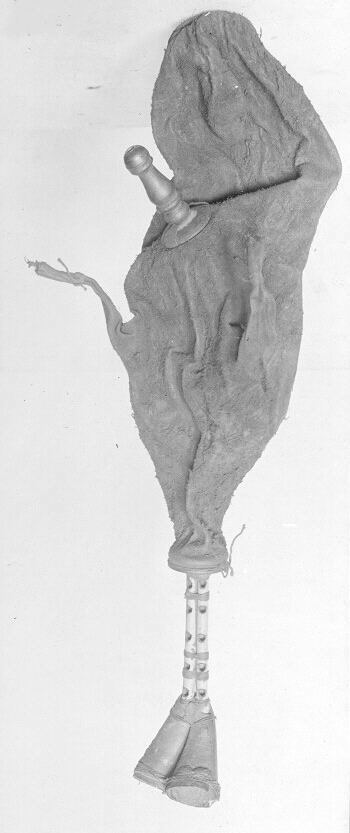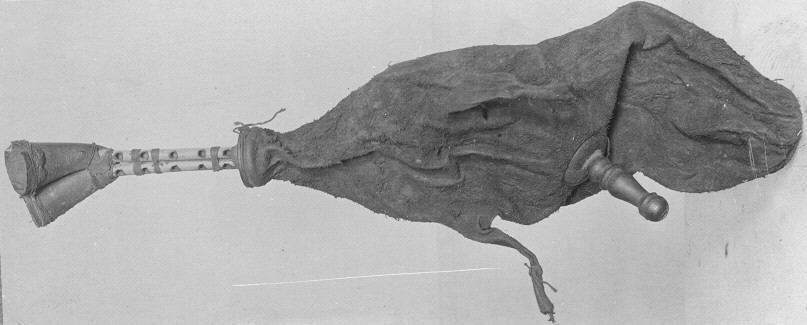Zuqqara
Not on view
The zuqqara is an instrument found across Northern Africa. Alternative names include zokra, zoukra (Libya), mezwed, mizwid, mezoud (Tunisia) or chekwa (Algeria). This instrument was bought from an itinerant musician in Egypt in 1902 by Mr. Daoud Tekla, the American Consul of Aswan. The instrument features two parallel melodic pipes with five fingerholes on each pipe, ended by two horns. Most likely made by the musician himself, the fingerholes are roughly cut, and one can still make out the knife marks around the fingerholes. This suggests that this instrument was quickly made by someone who was experienced and needed a functional instrument rather than an expertly finished one. The discrepancy between the turned blowpipe and the simplicity of the bag and chanter also points to the fact that the blowpipe was probably borrowed from another instrument. This is a common occurrence in these kind of multipart instruments, where functional pieces are re-used to make new instruments.
This specific type of Northern African bagpipe is most commonly found in Tunisia, where the local bagpipe (mizwid), documented since at least the late 19th century, features five fingerholes. There are very few historical references of bagpipes in Egypt, most of them from the beginning of the 19th century. Guillaume-Andre Villoteau, considered as one of the first musical ethnographers, was attached to Napoleon Bonaparte’s scientific mission to Egypt in 1798. During three years, he documented Egypt’s musical styles, and collected instruments. Despite actively looking for bagpipes he only found them three days before his departure in 1801 (Legrain 1917), suggesting that they were not easily found, nor commonly played, at least in the circles he moved in.
(Cassandre Balosso-Bardin, 2023)
Technical Description:
Two cane chanters with oblique ends and two horn bells, cylindrical bores, fingerholes;
holes knife-cut;
chanters tied together with waxed black string and cloth, and hemp-wrapped and waxed into a flat, disk-shaped wooden stock;
reeds inaccessible;
turned wooden blowpipe with disk-shaped integral stock, protruding 97 mm outside of bag, with wax band around mouthpiece and two flaps of leather emerging between bag and disk at base of pipe, indicating a flap vale inside;
rough, semi-tanned goatskin bag with hair turned in, with hind end tied off inside, fore legs tied outside with leather thongs, and chanter in neck.
References
Legrain, Georges, 1917. ‘Guillaume-Andre Villoteau, musicographe de l’expedition d’Egypte (1759-1839)’, Bulletin de l’Institut Egyptien, 56(11), p1-30.
Due to rights restrictions, this image cannot be enlarged, viewed at full screen, or downloaded.
This artwork is meant to be viewed from right to left. Scroll left to view more.




